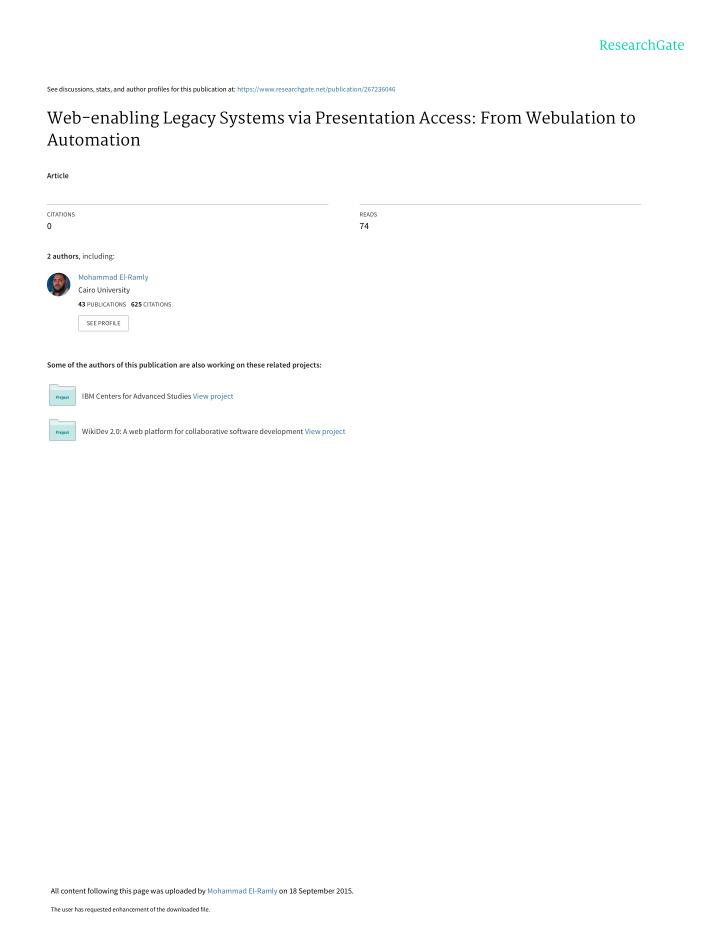



See discussions, stats, and author profiles for this publication at: https://www.researchgate.net/publication/267236046 Web-enabling Legacy Systems via Presentation Access: From Webulation to Automation Article CITATIONS READS 0 74 2 authors , including: Mohammad El-Ramly Cairo University 43 PUBLICATIONS 625 CITATIONS SEE PROFILE Some of the authors of this publication are also working on these related projects: IBM Centers for Advanced Studies View project WikiDev 2.0: A web platform for collaborative software development View project All content following this page was uploaded by Mohammad El-Ramly on 18 September 2015. The user has requested enhancement of the downloaded file.
Web-enabling Legacy Systems via Presentation Access: From Webulation to Automation Mohammad El-Ramly Eleni Stroulia Department of Computer Science Computing Science Department University of Leicester University of Alberta Leicester, LE1 7RH, UK Edmonton, T6G 2H1, Canada mer14@cs.le.ac.uk stroulia@cs.ualberta.ca reduction. This gave birth to a new research area: “Web- Abstract enabling legacy systems” to develop methods for opening existing legacy software for access through the Internet, After years of development and billions of invested an extranet and/or an intranet to the public and/or to a dollars, legacy mainframe systems have become the selected user-base of employees, customers, partners, etc. lifeblood of many corporations. And today, given the Separately, industry developed its own solutions as well. dramatic changes that the Internet revolution has brought A legacy software application in general, consists of to today’s business processes, it has become necessary to three layers: the presentation layer, the program logic make these systems accessible to partners, employees and layer and the data and data access layer. A Web customer. In principle, there are three different application can access a legacy system via one or more of approaches to that end: one can enable access to the these layers, depending on the available legacy and Web legacy system via its data, its logic or its presentation technologies. This requires reproducing the legacy layers. In this paper, we review the state-of-the-art in the business processes and data in new formats and last approach, namely Web-enabling via presentation presentations for the old and new users [ � 18], and possibly layer access. We discuss both academic research methods re-architecting the legacy application. and industrial practices, we describe their evolution and The challenge is that many legacy systems were their potential, and we comparatively evaluate their pros developed using the technology of the 1970s to mid- and cons. Finally, we present CelLEST, a lightweight 1980s. They have been modified many times by different method we developed for semi-automated reengineering programmers and frequently are poorly structured and and Web-enabling of legacy user interfaces. We present documented. Separation between data, logic, and how this method uses artificial-intelligence algorithms to leverage and advance current manual technology. presentation layers rarely exists. They were not designed with integration in mind. As a result, they have become 1. Introduction complex and difficult to understand, maintain, renovate, reengineer, and/or integrate with other systems. They Over years of development and investment, business aged! [ � 20, � 27] A main weakness of mainframe legacy software systems, such as bank finance systems, applications is their user interfaces (UIs). They fall short customer-relationship management (CRM) systems and in three areas: user access, usability and navigation: [ � 4] airline-reservation systems, grew in size and value. They User Access. Most legacy systems are proprietary constitute one of the most important assets for many monolithic systems that were not designed for integration companies. [ � 19] Corporations have invested substantially with the Web or other technologies. Usually they do not in developing these mainframe-based legacy systems and have clear separation between their presentation, logic making them Y2K and Euro compliant. [ � 25] and data layers. This makes opening a legacy system for In return, mainframe-based legacy systems have proven access via a new platform or for front-end integration reliability and scalability in providing business-critical with other systems a hard task. processing needs, especially for applications involving Usability. Legacy text-based UIs have limited display huge numbers of transactions and simultaneous users like capabilities, and are non-intuitive and hard to learn. They banking and airline-reservation applications. Moreover, were adequate for their time but dissatisfy today’s users, many of the business processes and policies of companies who are used to graphical user interfaces (GUIs) and Web are encapsulated in the logic of legacy systems. For many interfaces. Training their new users is slow and costly. corporations , legacy systems will remain their Information Navigation. The limited presentation capabilities of Technology (IT) backbone for years to come. [ � 3] legacy text-based UIs impose tedious navigation patterns When the Internet emerged as a medium for conducting to accomplish user tasks. E.g., flipping a multi-page business, it created new opportunities for growth and cost report may require using function keys or issuing some
Recommend
More recommend